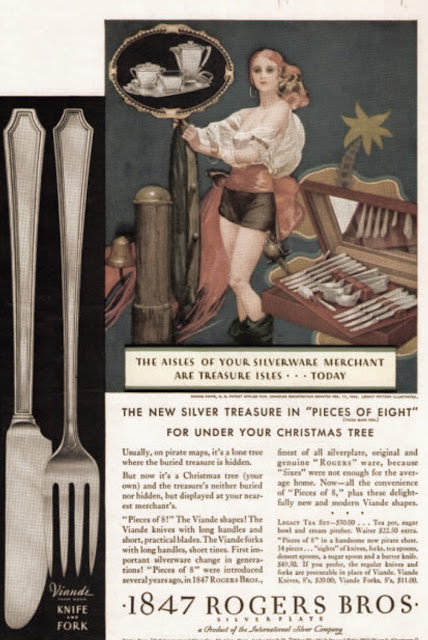Tea Time Magazine recommended its use at a Tea Table back in December of 2022, “The grille or viande style was popular through the 1950s. This knife design has a shorter blade and a longer handle and is usually the size of a luncheon knife, approximately 8½ inches, which makes it attractive on the tea table. ” Etiquipedia disagrees with this advice, and believes that “Youth” or “Pudding”/ “Dessert” sized flatware is much more appropriate, if one does not own “Tea” sized flatware. In fact, many Youth sized pieces were listed as Tea sized flatware and were interchangeable. (Note the mismatched cocktail fork above: Mixing patterns effectively can only work when patterns are from the same era or are similar in design, and the patina is nearly identical. They will then blend seamlessly to pull a complete period look together at one’s table.) |
 |
| Above, a grille-size knife… I was amused when one well known company suggested that grille sized flatware was invented for eating “delicacies from the grille.” The same company also surmised that the knives were “used for carving and serving food directly from the grill.” Perhaps this type of flatware did become popular at some point with outdoor grillers, but I have yet to find any evidence of this trend. Nor can I find any suggestion of this in advertising of the period. From a practical standpoint, knowing these feature fairly dull-edged knife blades, I cannot imagine using them for “carving” anything from the grille, unless we are discussing hamburgers. |
The Style Made its Debut in 1929“Table knives,” says Eliel Saarinen, the Detroit architect who showed a dining-room at the Metropolitan Museum exhibit, have been constructed on the wrong principle. “The blades have been much longer than necessary, while the handles have been much too short, so that the user, when cutting, has always been obliged to brace his finger well down on the blade, which has obvious disadvantages.”
Mr. Saarinen has designed some new knives which are quite as attractive as they are practical, and one wonders why we have so long clung to the old irrational and conventional kind. This search for the logical and simple is leading us away from some of our outdated habits.” — House Beautiful, May 1929
More on the briefly popular Grille Flatware
This settings above feature the style flatware known as, “Grille”, “Viande” and “Vogue.” The knife is about 2/3 handle and 1/3 blade, as opposed to the normal 1/2 handle with 1/2 blade. The handle of the fork is nearly 3/4 of the fork with the bowl and tines 1/4. This “modern” style of flatware was introduced first to the public in 1927.
According to a 2003 article by William P. Hood of Magazine Antiques, “The story begins in 1927 or 1928, when nine architects were invited by the Metropolitan Museum of Art in New York City to design thirteen room settings for The Architect and the Industrial Arts, its eleventh exhibition of contemporary American design. The organizers requested that all furnishings and accessories for a room be included, and they stipulated that no object to be displayed could already be in production.
The new flatware designed was sleek with patterns reminiscent of the skyscrapers dotting the skylines of modern cities. Several different American flatware companies produced the knives, forks and spoons. “The dinner knife executed by International Silver, for example, was 9 1/4 inches long, with its handle measuring about 6 inches. The handle of its dinner fork was about average (approximately 5 inches), but the functional end was shorter than usual, to match the abbreviated knife blade. The idea for the new style of table knife came from the perception that it is uncomfortable for the extended index finger to press against the narrow back (or ‘top’) of the blade when one cuts with a conventional knife.”
By 1930, the new style of flatware was available to the public, but its popularity only lasted about 25 to 30 years. The flatware shown in the setting above is the 1940 “Treasure” pattern, by Wm. Rogers. The dishes are early 1940’s “Desert Rose” Franciscan ware. — Maura J. Graber, 2023
🍽Etiquette Enthusiast, Maura J. Graber, is the Site Editor for the Etiquipedia© Etiquette Encyclopedia



No comments:
Post a Comment
Note: Only a member of this blog may post a comment.